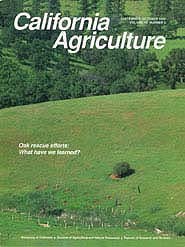All Issues

Oak rescue efforts: What have we learned?
Cover:
UC natural resources specialist Doug McCreary inspects plastic tree tubes shielding small oaks, willows and cottonwoods from rodents and grazing cattle. The goal is to restore more natural vegetation to this river bed at the Sierra Foothill Research and Extension Center. Photo by Jack Kelly Clark
September-October 1995
Volume 49, Number 5
Volume 49, Number 5





